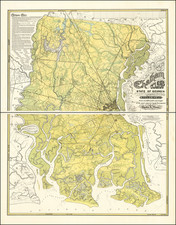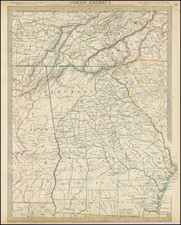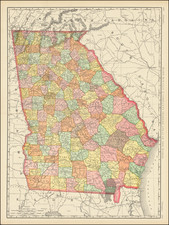The Third Traced Example. No Copies Have Appeared in Commerce. Not in De Renne.
The Wellborn-Green map is one of the exceptionally rare early separate maps of the State of Georgia, having appeared between the 1818 Sturges-Early Map of the State of Georgia and the 1847 Bonner Map of the State of Georgia.
The map was prepared in partnership by Calrton Wellborn and Orange Green shortly after the former had left his role as Surveyor General of Georgia. It seems probable that Wellborn carried some official knowledge with him into this project.
Aside from its extreme rarity, the map is notable for its failure to include any information about northwestern Georgia, which is simply labeled "CHEROKEES." The reason for this can be discerned from advertisements that the makers published in the first half of 1831.
PROPOSALS,
FOR Publishing by subscription, a Map of that Portion of Georgia, now occupied by the Cherokees. The subscribers would respectfully inform the public, that they intend, in addition to their NEW MAP OF GEORGIA, to publish as soon as the Sectional Surveyors have made their returns, a large and complete Map of the Cherokee country, wherein will be delineated all that can be pointed out on a Map.
The Map will be printed on strong silk paper, and as richly ornamented as any presented to the public, with as many gold regions, as minutely described; and delivered to subscribers for One Dollar and twenty-five cents- without any part in advance. CARLTON WELLBORN. ORANGE GREEN.
Milledgeville, March 10
So it seems clear enough that Wellborn and Green intended to follow up their map of the state with a map of the northwestern Cherokee (i.e., Gold) Country. It seems that this move was too clever by half, as they were beaten to the punch by John Bethune, Wellborn's old Surveyor General colleague. Bethune published his A map of that part of Georgia occupied by the Cherokee Indians only a few months after the Wellborn and Green advertisement appeared. One wonders if the modern rarity of the Wellborn and Green map might have followed poor sales as a result of not depicting the Cherokee region.
Green would publish A map of the second section of that part of Georgia known as the Cherokee Territory... in 1833. Wellborn's name is conspicuously absent from that map.
The map includes a table showing counties with the distance between the counties' "chief towns" and Milledgeville (the capital of Georgia from 1804 to 1868).
The Georgia Gold Rush
The Georgia Gold Rush was the second significant gold rush in the United States, preceded only by the North Carolina Gold Rush of 1799. It began in 1828 in present-day Lumpkin County near the county seat of Dahlonega, and it rapidly attracted thousands of prospectors, leading to a rapid influx of settlers and the establishment of boomtowns. The discovery of gold in Georgia also hastened the forced removal of the Cherokee Nation in what became known as the Trail of Tears, as settlers and the federal government sought to seize lands for gold mining. By the early 1840s, the easily accessible gold in Georgia had been largely exhausted, and many miners moved westward to pursue riches during the California Gold Rush of 1849. Today, Dahlonega commemorates its gold rush history with a Gold Museum, historical markers, and annual events.
Rarity
The map is extremely rare.
We locate examples at the Library of Congress (damaged) and the University of Georgia Hargett Library (heavily damaged).
An 1833 version of the map is known in a single example at the New York Public Library (heavily damaged).
We are not aware of another example of the map appearing at auction or in a dealer catalog.













![[ Carolinas & Georgia ] Carte De La Caroline Et Georgie . . .](https://storage.googleapis.com/raremaps/img/small/99744.jpg)
![[ Georgia - Margravate of Azilia ] A Plan representing the Form of Setling the Districts, or County Divisions in the Margravate of Azilia](https://storage.googleapis.com/raremaps/img/small/101398.jpg)

![[Florida/Georgia -- Mouth of St. Mary's River] Plan of Amelia Island In East Florida; A Chart of The Entrance Into St. Mary's River; A Chart of The Mouth of Nassau Rivers. By Captain William Fuller. 1770](https://storage.googleapis.com/raremaps/img/small/40410.jpg)